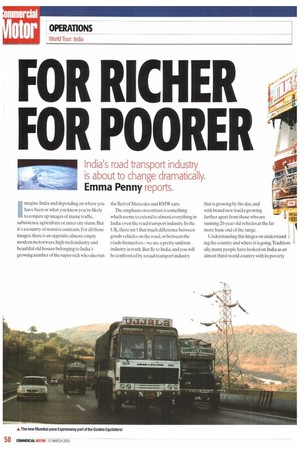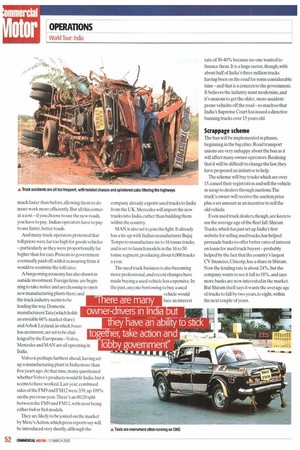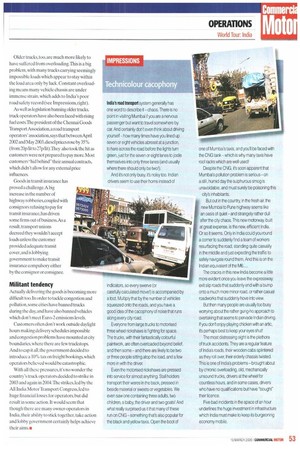FOR RICHER FOR POORER
Page 50

Page 51

Page 52

Page 53

If you've noticed an error in this article please click here to report it so we can fix it.
India's road transport industry is about to change dramatically.
Emma Penny reports.
Imagine India and depending on where you have been or what you know you're likely to conjure up images of manic traffic, subsistence agriculture or inner city slums. But it's a country of massive contrasts. For all those images, there is an opposite: almost-empty modern motorways, high-tech industry and beautiful old houses belonging to India's growing number of the super-rich who also run the fleet of Mercedes and BMW cars.
The emphasis on contrast is something which seems to extend to almost everything in India: even the road transport industry. In the UK, there isn't that much difference between goods vehicles on the road, or between the roads themselves — we are a pretty uniform industry in truth. But fly to India, and you will be confronted by a road transport industry that is growing by the day, and with brand new trucks growing further apart from those who are running 20-year old vehicles at the far more basic end of the range. Understanding this hinges on understandI ing the country and where it is going.Traditionally, many people have looked on India as an almost third-world country with its poverty and lack of infrastructure. But ills a different country today than it was even 10 years ago; high-tech industry is booming, the government is spending money on building better roads, and companies within India are setting out to export their goods onto a world market.
It is a growing economy. It is forecast to expand by more than 8% this year, higher than in the past 15 years, while exports grew by almost a quarter last year. Industrial production is rising, and agricultural production is also on the inerease.According to World Bank figures, India's present road transport system handles 870 billion tonne-km of freight a year (in 2003, UK figures were 152 billion tonne-km), and over the past 10 years, total transport demand has grown at 10% year-on-year.
That growth means there is an urgent need for efficient transport, which has led the Indian government to invest $12bn in a new road system, covering thousands of miles,The first phase of this, the 5,846km "Golden Equilaterarlinks the north, east,south and west of the country and is almost complete. It provides roads which are like dual carriageway or motorway, linking Bombay,Dehli, Madras and Calcutta— the major trade routes.The government is also paying for new roads to link the north and south, and the east and west — a further 7,300km of high spec roads. An extra rupee (1.2p) on every litre of petrol or diesel was levied to fund the project, which is due to be completed in 2007.
New roads should allow hauliers to travel much faster than before, allowing them to do more work more efficiently. But all this comes at a cost — if you choose to use the new roads, you have to pay. Indian operators have to pay to use faster, better roads.
And many truck operators protested that toll prices were far too high for goods vehicles — particularly as they were proportionally far higher than for cars Protests to government eventually paid off, with it reassuring firms it would re-examine the toll rates.
A burgeoning economy has also drawn in outside investment. Foreign firms are beginning to take notice and are choosing to open new manufacturing plants there and the truck industry seems to be leading the way. Domestic manufacturersTata (which holds an enviable 66% market share) and Ashok Leyland, in which Iveco has an interest, are set to be challenged by the Europeans—Volvo, Mercedes and MAN are all operating in India.
Volvo is perhaps furthest ahead, having set up a manufacturing plant in India more than five years ago. At that time, many questioned whether Volvo's products would fit India, but it seems to have worked. Last year. combined sales of the FM9 and FM12 were 339, up 109% on the previous year.There's an 80:20 split between the FM9 and FM12, with most being either 6x4 or 8x4 models.
They are likely to be joined on the market by Merc's Actros, which press reports say will be introduced very shortly, although the company already exports used trucks to India from the UK. Mercedes will import the new trucks into India, rather than building them within the country.
MAN is also set to join the fight. It already has a tie-up with Indian manufacturer Bajaj Tempo to manufacture six to 16 tonne trucks, and is set to launch models in the 16 to 50 tonne segment, producing about 6,000 trucks a year.
The used truck business is also becoming more professional, and recent changes have made buying a used vehicle less expensive. In the past, anyone borrowing to buy a used vehicle would face an interest rate of 30-40% because no-one wanted to finance them. It is a huge sector, though, with about half of India's three million trucks having been on the road for some considerable time — and that is a concern to the government. It believes the industry must modernise, and it's anxious to get the older, more accidentprone vehicles off the road — so much so that India's Supreme Court has issued a directive banning trucks over 15 years old.
Scrappage scheme
The ban will be implemented in phases, beginning in the big cities Road transport unions are very unhappy about the ban as it will affect many owner-operatorsRealising that it will be difficult to change the law, they have proposed an initiative to help.
The scheme will buy trucks which are over 15, cancel their registration and sell the vehicle as scrap to dealers through auctions.The truck's owner will receive the auction price plus a set amount as an incentive to sell the old vehicle.
Even used truck dealers, though, are keen to see the average age of the fleet fall. Shiram Trucks,which has just set up India's first website for selling used trucks, has helped persuade banks to offer better rates of interest on loans for used truck buyers — probably helped by the fact that the country's largest CV financier, Citicorp, has a share in Shiram. Now the lending rate is about 24% ,but the company wants to see it fall to 18%, and says more banks are now interested in the market. But Shiram itself says it wants the average age of trucks to fall by two years, to eight, within the next couple of years. Older trucks, too, are much more likely to have suffered from overloading. This is a big problem, with many trucks carrying seemingly impossible loads which appear to stay within the load area only by luck. Constant overloading means many vehicle chassis are under immense strain, which adds to India's poor road safety record (see Impressions, right).
As well as legislation banning older trucks, truck operators have also been faced with rising fuel costs.The president of the Chennai Goods Transport Association, a road transport operators' association,says that between April 2002 and May 2003, diesel prices rose by 35% (from 20p/lit to 27p111t).They also took the hit as customers were not prepared to pay more. Most customers "hid behind" their annual contracts, which didn't allow for any external price influences.
Goods in transit insurance has proved a challenge, A big increase in the number of highway robberies,coupled with consignors refusing to pay for transit insurance,has driven some firms out of business.As a result, transport unions decreed they wouldn't accept loads unless the customer provided adequate transit cover, and is lobbying government to make transit insurance compulsory either by the consignor or consignee.
Militant tendency
Actuallydelivering the goods is becoming more difficult too. In order to tackle congestion and pollution, some cities have banned trucks during the day, and have also banned vehicles which don't meet Euro-2 emissions levels.
Customers often don't work outside daylight hours making delivery schedules impossible and congestion problems have mounted at city boundaries, where there are few truckstops. And to cap it all, the government decided to introduce a 10% tax on freight bookings, which operators believed would be catastrophic.
With all these pressures, it's no wonder the country's truck operators decided to strike in 2003 and again in 2004. The strikes, led by the All India Motor Transport Congress, led to huge financial losses for operators, but did result in some action. It would seem that though there are many owner-operators in India, their ability to stick together. take action and lobby government certainly helps achieve their aims. ir










































































































































































































